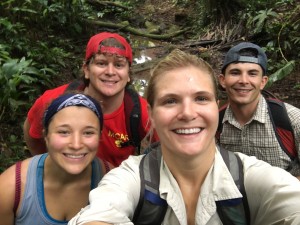We arrived at La Selva Biological Field Station in the middle of May right when the rainy season just started with a hefty list of objectives to tackle. One of these was to determine a question that we could test out in the field. A group of four us decided to see if we could gather some mammal data using camera traps. If I had to place the model of our camera traps into a category it would most likely be the Kia of the automobile industry. These wonderful devices have multiple settings to play with; so, we inputed all the different options in a way we though would benefit us the most. We hiked out into the jungle about a mile placing 5 camera traps about waist height facing the trail. The primary focus was to just get our feet wet and begin learning the best way to conduct a camera trap study. After 5 days, we collected all of the camera traps and downloaded our data to see what species we caught on camera. People appeared most frequently in all of the pictures that were downloaded, but we did manage to capture a lesser anteater and a peccary. We quickly learned some constraints with the options we chose in the settings and also the quality of our equipment. This short field experiment didn’t yield anything to classify this story as a page turner, but on the plus side we now know how to manage the settings of the camera traps for the next field test.
After realizing that we weren’t working with a Bentley in the camera trap world, we decided to run some quick trials testing the camera trap motion sensor. The field of view on our camera traps in very short and narrow meaning that placement of these cameras will need to be chosen wisely. Another plus of this short field experiment was the fact that we were able to develop some new questions with the data that we were able to gather. For example, the anteater image kicked us into brainstorming mode resulting in a pretty cool question, which is: do anteaters utilize the relationship between Cecropia trees and Aztec ants. The ants live in these trees where they benefit off each other. The ants protect the tree from herbivores, and the trees provide ants with nutrients. So now, we might utilize these camera traps to see if we can capture some lesser anteaters taking advantage of this relationship.
La Selva Biological Field Station is a great place to do research with many different resources at your fingertips. Our experience there was interactive and educational. Our group worked well together, and we had fun learning some new things.
